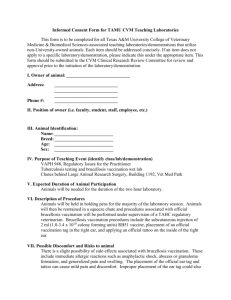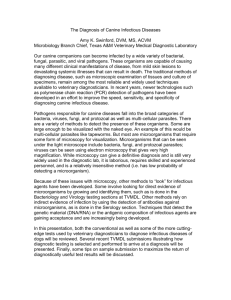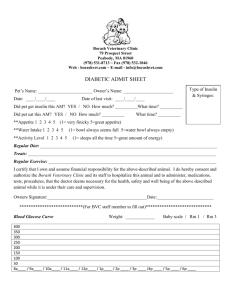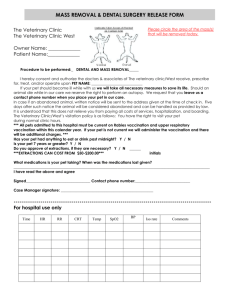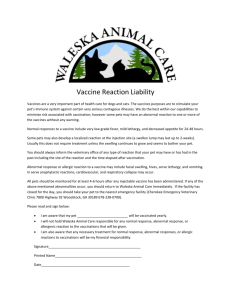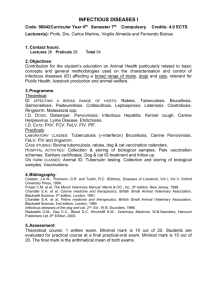Lesson Objectives: The students will identify the types of pathogens
advertisement
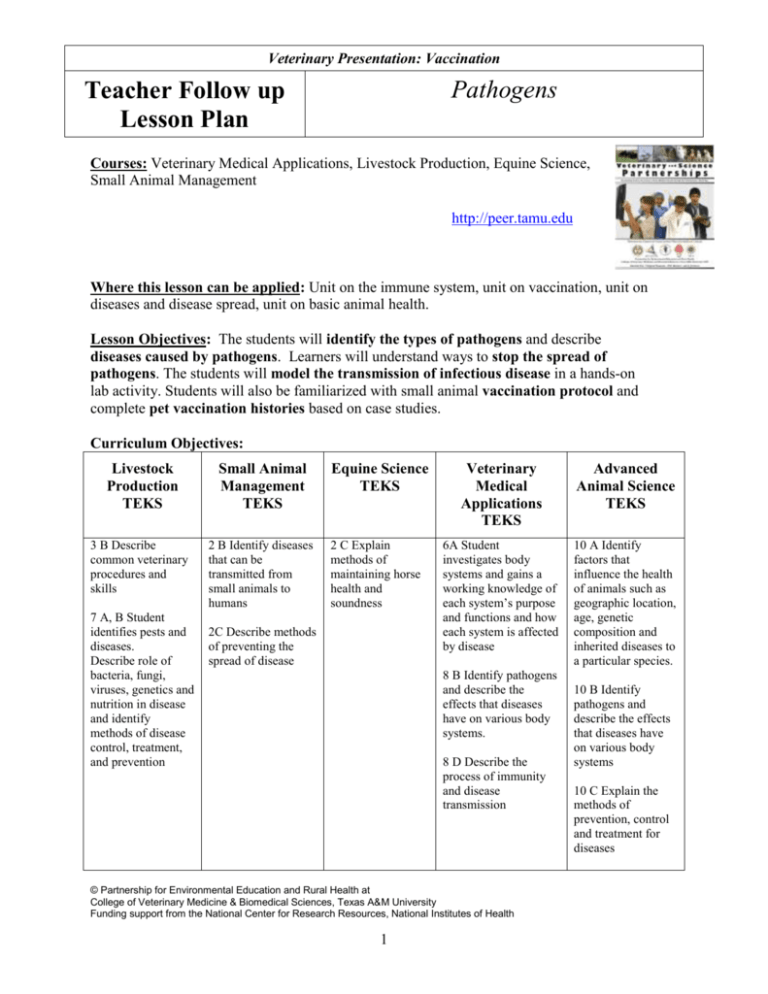
Veterinary Presentation: Vaccination Pathogens Teacher Follow up Lesson Plan Courses: Veterinary Medical Applications, Livestock Production, Equine Science, Small Animal Management http://peer.tamu.edu Where this lesson can be applied: Unit on the immune system, unit on vaccination, unit on diseases and disease spread, unit on basic animal health. Lesson Objectives: The students will identify the types of pathogens and describe diseases caused by pathogens. Learners will understand ways to stop the spread of pathogens. The students will model the transmission of infectious disease in a hands-on lab activity. Students will also be familiarized with small animal vaccination protocol and complete pet vaccination histories based on case studies. Curriculum Objectives: Livestock Production TEKS Small Animal Management TEKS 3 B Describe common veterinary procedures and skills 2 B Identify diseases that can be transmitted from small animals to humans 7 A, B Student identifies pests and diseases. Describe role of bacteria, fungi, viruses, genetics and nutrition in disease and identify methods of disease control, treatment, and prevention Equine Science TEKS 2 C Explain methods of maintaining horse health and soundness 2C Describe methods of preventing the spread of disease Veterinary Medical Applications TEKS Advanced Animal Science TEKS 6A Student investigates body systems and gains a working knowledge of each system’s purpose and functions and how each system is affected by disease 10 A Identify factors that influence the health of animals such as geographic location, age, genetic composition and inherited diseases to a particular species. 8 B Identify pathogens and describe the effects that diseases have on various body systems. 8 D Describe the process of immunity and disease transmission © Partnership for Environmental Education and Rural Health at College of Veterinary Medicine & Biomedical Sciences, Texas A&M University Funding support from the National Center for Research Resources, National Institutes of Health 1 10 B Identify pathogens and describe the effects that diseases have on various body systems 10 C Explain the methods of prevention, control and treatment for diseases Veterinary Presentation: Vaccination Pathogens Lesson Plan 10 D Describe the process of immunity and disease transmission. Background Information for Teacher: Infectious diseases and their spread are a cause of national attention due to recent outbreaks. Infectious diseases are caused by many types of organisms and affect different systems of the body. Veterinarians and physicians need to know the causes of diseases and recognize their symptoms. The public can help stop the transmission of infectious diseases by following several easy steps. Infectious pathogens include viruses, bacteria, fungi, protozoa, and abnormal proteins known as prions. Transmission of pathogens can occur in various ways including physical contact, contaminated food, body fluids, objects, airborne inhalation, or through vector organisms. Materials needed: Pathogens PowerPoint Infectious Disease Spread Activity-Teacher Infectious Disease Spread Activity-Student Pathogen Graphic Organizer For Disease Spread Activity: Plastic cups-one for every student (they can be washed and reused each period) Saturated baking soda solution Vinegar Distilled water Phenolphthalein indicator (see resources) or Boiled cabbage indicator (recipe included) Small syringes without needles (for extension) For Pet Health Record Activity: Pet Health Record Small Animal Vaccination Protocol Health Record Case Studies Sheet Lesson Procedures: PreparationVeterinary Presentation on Vaccination (1 class period) The veterinary visit will engage students to learn about required agricultural science topics. A veterinary video presentation and a veterinary student video presentation are also available. PresentationPathogens PowerPoint (1 class period) © Partnership for Environmental Education and Rural Health at College of Veterinary Medicine & Biomedical Sciences, Texas A&M University Funding support from the National Center for Research Resources, National Institutes of Health 2 Veterinary Presentation: Vaccination Pathogens Lesson Plan o A PowerPoint Presentation is provided. It covers the main types of pathogens. The presentation shows different types of diseases and specifies the pathogens they are caused by. It also presents ways to prevent the spread of pathogens. Due to the large number of pathogens, the tables of common diseases show only a fraction of the possible diseases caused by the pathogens. Method of transmission of each disease is not shown on this chart. As an extension, students could be given a disease to study and asked to report on symptoms and method of transmission. Many more examples of small animal diseases are given in the “Vaccination Protocol Activity” below. o Many “thinking” questions are posed and a few “Quick Checks” are provided with review questions to add several opportunities during the PowerPoint for student involvement. o Answers to the “Quick Checks” and other notes are included in the notes section of the PowerPoint when it is in edit view. o There is a graphic organizer on pathogens provided for use. This organizer is a five-part chart that is titled “Pathogens.” There is a section for each of the five pathogens mentioned. The students could label each section with the name of the pathogen and then fill out information to aid note taking. o Many references are included in the notes section of this PowerPoint presentation when viewed in the edit mode. ApplicationInfectious Disease Spread Activity (1 class period) o Students investigate the spread of infectious diseases in a hands-on, safe way. o Students are given cups of water to share (by pouring) as they visit person-toperson. o One cup represents an “infected” student or animal and has a saturated baking soda solution. The “infected” student does not know that he/she is “infected.” o At the conclusion of the activity, the teacher tests the cups with a simple acid/base indicator. The “infected” students’ water will change color. o Teachers should do the activity in advance to test the acid/base indicator for effectiveness. Distilled water should be used rather than tap water. Tap water affects the outcome of the indicator test. o A good post-activity discussion is provided along with an Infectious Disease Spread Activity Sheet. o To Evaluate this activity worksheet, students could trade and grade in class. This could be a part of the class discussion. The teacher could grade traditionally, by taking points off for each question. Extension - (1/2 to 1 class period) o An extension of the Infectious Disease Spread Activity is given. In this extension, students acting as mosquitoes are introduced into the Infectious © Partnership for Environmental Education and Rural Health at College of Veterinary Medicine & Biomedical Sciences, Texas A&M University Funding support from the National Center for Research Resources, National Institutes of Health 3 Veterinary Presentation: Vaccination Pathogens Lesson Plan Disease Spread Activity. The mosquitoes are given instructions on how to “bite” students. Some of the mosquitoes are “infected” and some are not. A follow-up discussion comparing methods of disease transmission could be used to stimulate higher level thinking skills. Application Option TwoVaccination Protocol and Case History (1 class period) o Students become familiar with a sample vaccination protocol for small animals and apply that protocol to recording vaccination histories for case studies. o Students are given Small Animal Vaccination Protocol Sheet. Students should read the sheet and become familiar with the recommendations. Note: These vaccination protocols are for the use of this activity only. Students and teachers should be aware that vaccination protocols vary depending on the age, breed, and health status of the animal, the potential of the animal to be exposed to the disease, the type of vaccine, whether the animal is used for breeding, and the geographical area where the animal lives or may visit. o Students are then given a Pet Health Record for each of the Health Record Case Studies that the teacher directs the students to complete. Students may work in small groups; each group could complete one Pet Health Record per case study. o Students should complete the vaccination portion of the Pet Health Record for each case study. Students are instructed to include dates for the future recommended vaccinations according to the Small Animal Vaccination Protocol. o Students may be instructed to use fictitious owner names, veterinary names, and rabies tag numbers if desired. o Some of the vaccines included in the checklist of the Pet Health Record are not included in the protocols. Students should be instructed that these vaccines are not core vaccines and administration of these vary. Teacher may wish to instruct students to research these vaccines and present information about their use. o Teacher may wish to instruct students on whether or not to include optional vaccines/tests that are listed in their future recommendations. o The notations of “Canine” and “Feline” at the top of the Vaccination record may be a little confusing. Rabies is for both canine and feline patients but is listed closer to the “Feline” label. Evaluation StepThe Infectious Disease Spread Activity Worksheet can be graded (see suggestion above). Also, “Quick Checks” are included in the PowerPoint presentation as benchmarks to evaluate if students understand the materials presented. The vaccination protocol and case history can be traditionally graded, taking into consideration the students responses to the “optional” vaccines/tests. Dates on the Pet Health Record will vary according to the day the assignment is completed. © Partnership for Environmental Education and Rural Health at College of Veterinary Medicine & Biomedical Sciences, Texas A&M University Funding support from the National Center for Research Resources, National Institutes of Health 4 Veterinary Presentation: Vaccination Pathogens Lesson Plan Resources for Teacher: Sources for Phenolphthalein Indicator Scholar Chemistry http://www.scholarchemistry.com/groups.php?id=15439 Sargent-Welch http://sargentwelch.com/phenolphthalein-phenolphthalein-lab-grade-100-g-phindicator-powder-ph-80-100%3B-clear-to-red-shelf-life-indefinite-non-hazardous85090-02/p/WLC94654-04_EA/ Other PEER Resources: The Body’s Defenses http://peer.tamu.edu/curriculum_modules/OrganSystems/Module_1/index.htm You Tube Video on Influenza Epidemic of 1918 http://www.youtube.com/watch?v=tpzxNoLZx0w Are Viruses Alive? http://serc.carleton.edu/microbelife/yellowstone/viruslive.html http://cvr.bio.uci.edu/downloads/Scientific_Amer.pdf Interactive Tutorial on Bacterial Growth Curve http://www.cellsalive.com/ecoli.htm Information on edible vaccines: http://www.mcdb.ucla.edu/Research/Goldberg/hc70a_w04/pdf/Edible_Vaccine.pdf References: Veterinary Assistant Handbook Floron C. Fairies, Jr. Instructional Material Service Texas A&M University First Edition Merck Veterinary Manual: http://www.merckvetmanual.com/ For more references, please see notes section in the PowerPoint presentation. © Partnership for Environmental Education and Rural Health at College of Veterinary Medicine & Biomedical Sciences, Texas A&M University Funding support from the National Center for Research Resources, National Institutes of Health 5



